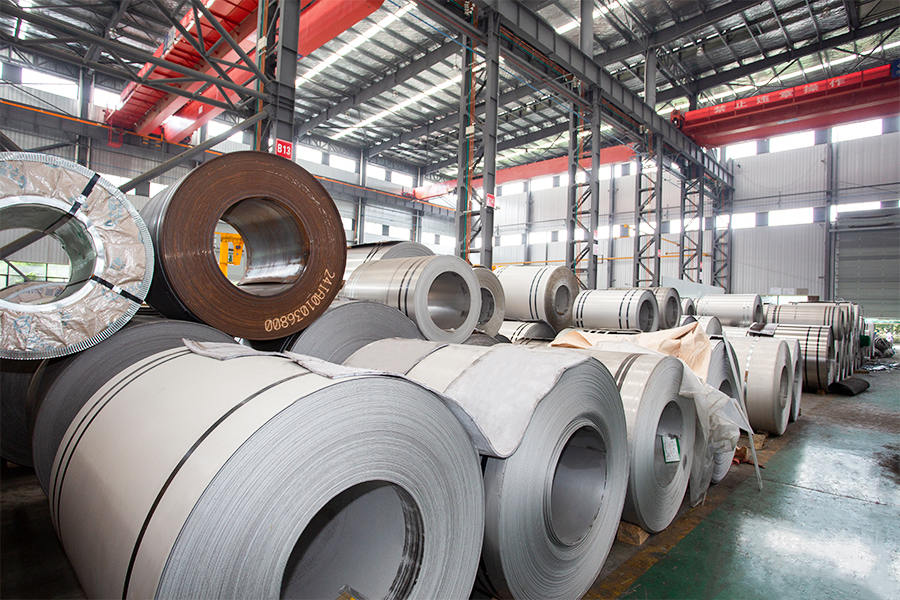304 vs. 316 Stainless Steel Coils: Key Differences and Applications
Introduction
Stainless steel coils are widely used in industries such as construction, automotive, food processing, and marine engineering due to their corrosion resistance, strength, and versatility. Among the most common grades are 304 and 316 stainless steel, each offering distinct properties that make them suitable for different environments.
1. Chemical Composition: The Core Difference
The primary distinction between 304 and 316 stainless steel lies in their alloying elements, which affect performance in various conditions.
Element (%) 304 Stainless Steel 316 Stainless Steel
Chromium (Cr) 18-20% 16-18%
Nickel (Ni) 8-10.5% 10-14%
Molybdenum (Mo) None 2-3% (key difference)
Carbon (C) ≤0.08% ≤0.08%
Manganese (Mn) ≤2% ≤2%
Why Does Molybdenum Matter?
316 stainless steel contains 2-3% molybdenum, significantly enhancing its resistance to:
Chloride corrosion (e.g., seawater, de-icing salts).
Acidic environments (e.g., chemical processing).
304 lacks molybdenum, making it more susceptible to pitting and crevice corrosion in harsh conditions.
2. Corrosion Resistance Comparison
A. General Corrosion Resistance
Both grades resist rust and oxidation well in mild environments (indoor, dry climates).
304 is sufficient for:
Kitchen equipment
Architectural trim
Storage tanks (non-aggressive liquids)
316 is superior in:
Marine environments
Chemical plants
Coastal construction
B. Chloride & Saltwater Resistance
Environment 304 Performance 316 Performance
Saltwater Exposure Prone to pitting corrosion Highly resistant
Chlorine (Swimming Pools) Moderate resistance Excellent resistance
Industrial Chemicals Limited resistance Strong resistance
Key Takeaway:
Use 316 near saltwater or chemical exposure.
304 is cost-effective for general-purpose applications.
3. Mechanical Properties & Strength
Both grades are austenitic stainless steels, offering good ductility and weldability. However, slight differences exist:
| Property | 304 Stainless Steel | 316 Stainless Steel |
|---|---|---|
| Tensile Strength | 515 MPa (75,000 psi) | 515 MPa (75,000 psi) |
| Yield Strength | 205 MPa (30,000 psi) | 205 MPa (30,000 psi) |
| Hardness (Brinell) | 201 HB | 217 HB |
| Elongation at Break | 40% | 40% |
Key Observations:
Similar strength, but 316 is slightly harder due to molybdenum.
Both are non-magnetic in annealed condition (but may become slightly magnetic after cold working).
4. Cost Comparison
316 stainless steel is ~20-40% more expensive than 304 due to molybdenum content.
304 is more economical for non-corrosive applications.
When to Choose 316 Despite Higher Cost?
Marine applications (boat fittings, offshore platforms).
Chemical processing equipment.
Medical implants & pharmaceutical machinery.
5. Common Applications of 304 vs. 316 Coils
A. 304 Stainless Steel Coil Uses
Food & Beverage Equipment (sinks, storage tanks).
Architectural Trim (elevators, railings).
Automotive Exhaust Systems (non-coastal areas).
Household Appliances (refrigerators, dishwashers).
B. 316 Stainless Steel Coil Uses
Marine Hardware (boat fittings, shipbuilding).
Chemical & Pharmaceutical Tanks (acid-resistant).
Medical Devices (surgical tools, implants).
Coastal Construction (bridges, seawalls).

6. How to Choose Between 304 and 316?
Choose 304 If:
Budget is a priority.
Application is in a mild, non-corrosive environment.
Used for indoor or dry conditions (e.g., kitchen equipment).
Choose 316 If:
Exposure to saltwater, chlorides, or chemicals.
Long-term durability in harsh environments is needed.
Used in medical or high-purity applications.
7. Future Trends in Stainless Steel Coils
Lean 316 variants (reduced nickel for cost savings).
High-nitrogen stainless steels (improved strength).
Eco-friendly coatings for enhanced corrosion resistance.
Conclusion
While 304 and 316 stainless steel coils share similarities, the addition of molybdenum in 316 makes it far superior in corrosive environments.
Summary of Key Differences:
| Factor | 304 Stainless Steel | 316 Stainless Steel |
|---|---|---|
| Molybdenum Content | No | 2-3% |
| Corrosion Resistance | Good | Excellent (especially vs. chlorides) |
| Cost | Lower | Higher |
| Best For | Indoor, dry, food-grade | Marine, chemical, medical |
Final Recommendation:
For most general uses → 304 is sufficient and cost-effective.
For harsh or marine environments → 316 is worth the investment.
By understanding these differences, engineers and manufacturers can select the best stainless steel coil for their specific needs.


 English
English русский
русский عربى
عربى 中文简体
中文简体
